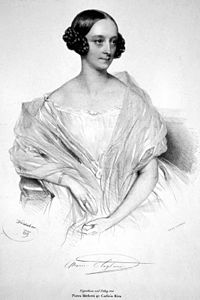Ballet of the Nuns
| Ballet of the Nuns | |
|---|---|

Marie Taglioni, 1839
|
|
| Choreographer | Filippo Taglioni |
| Music | Giacomo Meyerbeer |
| Libretto | Eugène Scribe |
| Based on | Quarante miracles dits de Notre-Dame |
| Premiere | 22 November 1831 Paris Opéra |
| Original ballet company | Paris Opéra Ballet |
| Characters | Bertram Robert le Diable Helena, an Abbess Ghosts of Nuns |
| Design | Henri Duponchel Pierre Ciceri |
| Setting | Sainte-Rosalie Cloister in ruins |
| Created for | Marie Taglioni |
| Genre | Gothic Romanticism |
| Type | Romantic ballet |
Ballet of the Nuns is the first ballet blanc and the first romantic ballet. It is an episode in Act 3 of Giacomo Meyerbeer's grand opera, Robert le diable. It was first performed in November 1831 at the Paris Opéra. The choreography (now lost) was created by either Filippo Taglioni or Jean Coralli.
The short ballet tells of deceased nuns rising from their tombs in a ruined cloister. Their aim is to seduce the knight, Robert le Diable, into accepting a talisman to win him a princess. At the end of the ballet, the white-clad nuns return to their tombs. The ballet was created (in part) to demonstrate the building's newly installed gas lighting. The lighting was capable of creating ghastly effects.
Ballet of the Nuns starred Marie Taglioni as the Abbess Helena. Although opening night was marred with a few mishaps, Taglioni made her indelible mark on the ballet world in the role. She became known for her ethereal qualities and her moral purity, and is one of the most celebrated ballerinas in history.
The ballet opens with Bertram, Robert le Diable's father, entering the ruined cloister of Sainte-Rosalie. He summons the ghosts of nuns who have violated their vows. They rise from their graves. He orders them to seduce his son Robert into accepting a deadly talisman. The Abbess Helena orders the ghosts to waltz. In spite of their sacred vows, the nuns waltz. The dead nuns give themselves over to unholy thrills.
Robert enters. The nuns hide, but return to prevent his escape. Robert stands terrified before a saint's tomb. The Abbess lures him towards the talisman in the saint's hand. Robert seizes it. The nuns continue their dance, fluttering like white moths. Their graves open and they sink into the earth. Stone slabs slide into place, covering the dead. A choir of demons is heard.
Ballet of the 18th century was based on rational thought and classical art. The French Revolution however ushered in a period that brought romantic ballet to the stage. Trapdoors, gas lighting, and other elements that became associated with the romantic ballet had been used in the popular theaters on the Paris boulevards for some time. Such elements would gain official sanction and prestige at the Paris Opéra in the middle decades of the 19th century.
...
Wikipedia
